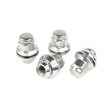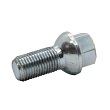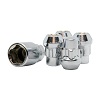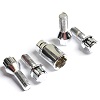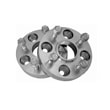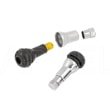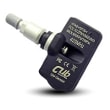How to read the markings on the rims? Rim parameters
An alloy wheel is a product that must be correctly and precisely adjusted to the car. This is related to safety and compliance with the law. It also enables trouble-free tire fitting. All this is possible by normalizing the properties of each wheel. Rim designations consist of so many parameters, because the variety of available vehicles is huge. What are the basic properties that describe practically every rim?
Basic rim parameters that should be checked before purchase
The basic markings on the rims include: rim size, number of bolt holes, mounting bolt spacing, rim width, ET and center hole diameter. All given markings refer to the geometry, i.e. the dimensions of a given rim. Let's see which specific dimensions correspond to which parameter. Deciphering the symbols on the rims will help us with this
Rim dimensions and markings
The graphic below shows the basic geometric parameters of the rims. We also provide details of each designation

[A] Rim size - is the diameter of the entire rim in inches. Possible rim sizes for a given car are predetermined by the manufacturer. This is important because it allows you to fit the entire wheel in the wheel arch. This is also important due to the size of the braking system. A large brake disc with a multi-piston caliper requires a rim that will "accommodate" the entire system. Therefore, it is worth using rims in the size provided by the manufacturer. Any change to a size other than provided by the manufacturer must be preceded by appropriate verification. You should also take into account the loss of warranty in the case of vehicles that have it.
[B] Rim width - is measured between the inner surfaces of the rim flanges. It is given in inches. When selecting tires for the rim, this parameter and the recommendations of the car manufacturer should be taken into account. The width of the rim is a parameter that affects whether the rim will fit in the wheel arch and will not rub against it - for example when turning.
[C] Spacing of mounting bolts and their number - this parameter of each rim is always given in the format a x b [mm], where a is the number of mounting holes , and b is the hole spacing, i.e. the diameter of the circle on which the holes are located. They are always placed evenly and axially. The diameter of this circle, as opposed to the diameter of the entire rim, is expressed in mm. The number of mounting holes must correspond to the number of screws (studs) on the hub of a given vehicle.
[D] ET - parameter ET (from German Einpress Tiefe) is an offset or offset. It is given in millimeters and is closely related to the width of a specific rim. Behind it is the distance between the mounting surface and the rim's symmetry axis.
[E] Rim center hole - this is a dimension given in millimeters and determines the diameter of the rim's center hole. If the car has a smaller hub diameter, it is possible to use additional centering rings.
Where to look for markings on alloy wheels?
Each rim model has its own designation, which is assigned by the manufacturer. You can find it on the rim - it's often stamped on the inside of the rim , for example on one of the spokes. The pictures below show one of our alloy wheels. As you can see, you can easily read all the markings on it.




The rim markings can also be found on the carton or product card in our online shop with rims and tires. There you can also read the technical parameters of the aluminum rim, thanks to which you can perfectly match the rim to your car.
Where to look for markings on steel rims?
Markings are assigned by the manufacturer. As with alloy wheels, steel wheels also have embossed markings - each manufacturer places them differently, but you can usually find them on the front of the wheel . Thanks to them, you can perfectly match the steel rim to your car. The pictures below show the nibs available in our store and as you can see, you can easily read all the technical parameters on them.


What do the symbols on the rims mean?
An exemplary rim designation may look like this: 17x7.5J 5x112 ET38 66.5 . What do we learn from this record? let's see:
- 17 - rim diameter expressed in inches,
- 7.5 - rim width expressed in inches,
- J - is a flange profile dedicated to passenger cars,
- ET38 - is a car rim offset of 38 mm,
- 66.5 - diameter of the central hole expressed in mm.
How to read rim ET?
ET is a dimension in millimeters. Indicates the distance between the mounting plane (the contact surface of the wheel rim with the vehicle hub) and the axis of symmetry of the wheel (the plane passing through the center of the rim width). The figure below shows which distance is the ET parameter.

To determine the ET, simply measure the distance between any point on the mounting plane inside the rim that is directly adjacent to the wheel hub and the center line of the rim. However, in practice this is not always easy. In addition, in this case, the measurement must be accurate to the millimeter. Therefore, the ET marking on the rims is commonly used. This facilitates quick reading of the value of this parameter.
ET calculations are of particular importance if we want to use rims with a different width than stock. Wheels wider than the original ones are one of the most common tuning procedures. Where the rim sits relative to the vehicle depends not only on the ET value. Width is also important. The edge of a 9.5" wide rim will be further out from the center of the vehicle than a 7.5" rim - even if their ET value is identical.
The correct selection of rims for each car
Rim markings contain a lot of important information, so before buying your dream rims for your car you should carefully verify these parameters. Our selection configurator is helpful - both according to the car model and the size of the rim. In case of doubt, our qualified team will be happy to help you choose the right alloy wheels.




 Nowoczesny design
Nowoczesny design Idealne dopasowanie
Idealne dopasowanie Duża wytrzymałość
Duża wytrzymałość Wysyłka gratis w 24h
Wysyłka gratis w 24h
 Indywidualny projekt
Indywidualny projekt Dedykowany opiekun
Dedykowany opiekun
